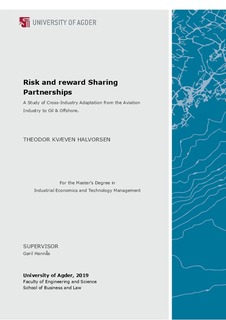| dc.description.abstract | After the 2014 drop in oil prices, there was a need for several organizations in the Norwegian oil and offshore sector to optimize their operations. One of these companies, MacGregor AS, wished to innovate their supply chains to face certain challenges. One solution they considered was to adopt a partnership model from the aerospace industry called risk and reward sharing partnerships (RRSP). Traditional procurement strategies usually involve a buyer and a supplier. The buyer purchases a good or service from the supplier, and further refines the product before selling it to customer. However, in the RRSP contractsthe supplier and buyercooperate in the design, production and life cycle support of a single product.By doing so, the supplier will collaborate with the client by contributing either by funding, expertise or resources that is necessary for the development of the product. In return, the supplier is considered a co-owner of the product, and are entitled toa share of the future revenue.The intention of this study is to consider whether the RRSP is adaptable to other industries through the problem statement:“How may risk and rewardsharingpartnership contracts be adapted to other industries?”It was uncovered two research gaps in this study. The first considered the antecedents for using RRSP, i.e. contextual prerequisites. The second research gap concerned the lack of a supplier perspective on the RRSP constellations. Both are considered important when discussing whether the RRSP would be a good fit for other industries, as well as when considering any necessary adjustments.To answer this question, an abductive, qualitative case study was initiated with two supplier organizations from the aerospace industry, as well as a market study. MacGregor AS was also used as a case study to evaluate the transferability of the RRSP.The study will consist of three research questions that aim at identifying the output from the RRSP, which is the benefits and disadvantages of the partnership model. Next step is to identify the input factors for these outputs, which will be the prerequisites of the RRSP constellations.
IIIThe final step is to evaluate the transferability of these prerequisites using MacGregor as a case study.The result was a model that describes the absolute requirements for using the RRSP, before identifying the different outcomes the RRSP is associated with. Once the output is defined, the model links up the output with the contextual explanations that hasresulted in this benefit, in order to evaluate how this compares to the new situation.The results were that it is reasonable to believe that the RRSP is transferable to other industries. This is because the RRSP is already used on a quite diverse portfolio of products and components with several different business models, meaning it is no reason to believe it is not applicable in other contexts. The only limiting factor that has been identified has to do with the excessive regulations and competitive situation in the industry, as there has been identified what appears to be a significant buyer-power due to the suppliers’ dependency on a few buyers, which is why the supplier benefits are usually associated with long-term opportunities.It is hence expected that MacGregor, with some minor alterations can use the RRSP with its suppliers to solveseveral of the challenges they face. However, it is argued that a supplier-focus is not necessarily the most favorable option due to MacGregor’s strategic intentionto use the RRSP as a tool to solve agency problems, which is not what the RRSP is intendedto be used as. By adopting the RRSP with MacGregor’s customers, it is very likely that they will solve their challenges, as well as the supplier-benefits of the RRSP which is associated with higher profit margins and predictability in cash flows. | nb_NO |

